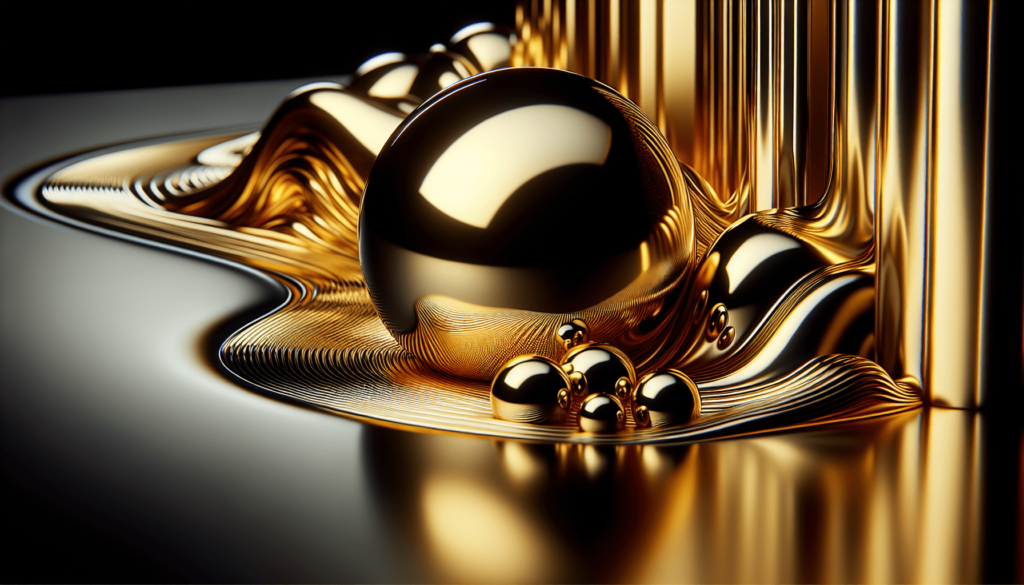Imagine a world without gold. The absence of its lustrous hue would leave a void in our perception of beauty and elegance. Gold’s influence on modern design and architecture is undeniable, shaping the way we perceive and experience these fields. From opulent interior decorations to iconic skyscrapers, this precious metal has left an indelible mark on our built environment. Join us as we explore the captivating history and current impact of gold in shaping the aesthetic landscape of the modern world.

Introduction
Gold has long been revered for its beauty, rarity, and symbolism. Throughout history, it has played a significant role in design and architecture, spanning ancient civilizations to modern-day trends. This article explores the historical significance of gold in design and architecture, as well as its incorporation into modern aesthetics. We will also delve into the role of gold as a material and its impact on art and sculpture. Additionally, we will discuss environmental and ethical considerations, the symbolism of gold in modern society, the challenges and limitations in working with gold, and future trends in gold-inspired design and architecture.
Historical Significance of Gold in Design and Architecture
Ancient civilizations and the use of gold in design
From the accomplishment of ancient Egyptians to the opulence of ancient Greeks, gold held a prominent place in the design and architecture of various civilizations. The Egyptians adorned elaborate tombs and temples with gold leaf, believing it to be the flesh of the gods. The Greeks, too, embraced the use of gold in their art and architecture, using it to create intricate jewelry, statues, and architectural details.
Religious and cultural significance of gold in art and architecture
Gold has also held deep religious and cultural significance throughout history. In many cultures, gold has been associated with divinity, representing the sun, spiritual enlightenment, and higher realms. In religious and sacred architecture, gold is often used to embellish altars, religious icons, and sacred spaces, creating a sense of awe and transcendence.
Gold as a symbol of wealth and power
Throughout history, gold has been synonymous with wealth and power. Its scarcity and preciousness have made it a symbol of opulence and luxury. From the glimmering crowns of royalty to the extravagant palaces of the elite, gold has often been used to denote social status and affluence. Even today, gold continues to evoke a sense of prestige and exclusivity.
Incorporating Gold into Modern Design
Emerging trends of using gold in contemporary design
In recent years, there has been a resurgence of gold in contemporary design. Designers and architects have been exploring new ways to incorporate gold, whether in subtle accents or bold statements. Gold is now being used in innovative ways, transcending its traditional associations and taking on fresh interpretations.
Use of gold accents in interior design
One of the popular ways gold is being incorporated into modern design is through the use of gold accents in interior spaces. Gold accents, such as metallic finishes on fixtures and furnishings, bring a touch of glamour and sophistication to any room. Whether it be a gold chandelier, golden drawer pulls, or a gold-trimmed mirror, these accents add a sense of luxury and elegance.
Gold finishes in furniture and accessories
Gold finishes in furniture and accessories have also become increasingly popular in contemporary design. From gold-plated chairs to gold-leafed tables, these pieces create a sense of opulence and grandeur. Gold finishes add a touch of refinement and timelessness to any space, making them a favored choice among interior designers and homeowners alike.
Gold’s Role in Architecture
Gold cladding in modern architectural designs
In modern architectural designs, gold cladding has emerged as an exciting trend. The use of gold cladding on building exteriors adds a striking visual element, catching the eye and elevating the overall aesthetic. Whether it be a sleek and modern skyscraper or a historic building undergoing restoration, gold cladding adds a touch of luxury and elegance.
Application of gold leaf in architectural details
Gold leaf, a thin layer of gold, is being applied to architectural details, enhancing their visual impact. Ornate moldings, intricate carvings, and decorative elements are often adorned with gold leaf to create a sense of richness and refinement. The application of gold leaf adds depth and texture, giving architectural details a timeless and exquisite appearance.
Golden domes and spires in religious architecture
In religious architecture, golden domes and spires continue to be a defining feature. These gilded structures symbolize spirituality, transcendence, and divinity. The shimmering gold roofs draw the eye and create a sense of reverence, often marking sacred spaces and highlighting their importance.

Gold as a Material in Modern Design
Gold as a material for jewelry and fashion accessories
Gold has long been used as a material for jewelry and fashion accessories. Its malleability, durability, and timeless appeal make it a favorite among designers and consumers alike. From delicate necklaces to statement rings, gold pieces not only add a touch of luxury but also serve as long-lasting heirlooms.
Modern technology and techniques for working with gold
Advancements in modern technology have allowed for more intricate and innovative use of gold in design. From laser-cutting techniques to 3D printing, these technological advancements have pushed the boundaries of how gold can be incorporated into various products. This has opened up new possibilities for designers to create intricate and unique gold pieces.
Innovative uses of gold in product design
Designers are also finding innovative ways to incorporate gold into product design beyond traditional applications. From gold-infused ceramics to gold-plated electronics, the use of gold adds a sense of exclusivity and luxury to everyday items, elevating their value and desirability.
The Influence of Gold in Art and Sculpture
Symbolic representation of gold in contemporary art
Contemporary artists often use gold as a symbolic representation in their works. The presence of gold in art can signify power, purity, enlightenment, or even the fleeting nature of wealth. Artists utilize this symbolism to provoke thought and explore deeper meanings within their creations.
Gold as a medium in sculpture and installations
Gold has long been used as a medium in sculpture and installations, allowing artists to shape and mold the material to their vision. Its luster and reflectivity add a dynamic quality to these artworks, capturing and reflecting light in intriguing ways. Whether through traditional sculptures or avant-garde installations, gold remains an important choice for many artists.
Gold’s role in art movements and styles
Throughout art history, gold has played a significant role in various art movements and styles. From the opulence of the Baroque period to the minimalist use of gold in modern art, each movement has utilized gold to convey specific aesthetic or conceptual intentions. Whether as a primary element or a subtle accent, gold has left an indelible mark on the art world.
Environmental and Ethical Considerations
Sustainable and ethical sourcing of gold
As the demand for gold continues to rise, it is imperative to consider the environmental and ethical implications of its sourcing. Sustainable and ethical mining practices, such as responsible sourcing and fair trade initiatives, are crucial in minimizing the negative impact on ecosystems and ensuring the well-being of workers involved in the extraction process.
Alternatives to using gold in design and architecture
Designers and architects are exploring alternatives to using gold in order to mitigate its environmental impact and promote sustainability. Materials such as recycled metals, eco-friendly alloys, and gold substitutes offer creative solutions that reduce the reliance on traditional gold mining practices while still maintaining the desired aesthetic qualities.
Balancing luxury with sustainability
Incorporating gold into design and architecture requires a delicate balance between luxury and sustainability. Designers and architects must be mindful of their choices, aiming to create beautiful and luxurious spaces while minimizing the environmental footprint. By considering sustainable materials, reducing waste, and prioritizing ethical practices, it is possible to strike this balance and create a more sustainable future.
The Symbolism and Perception of Gold in Modern Society
Gold as a status symbol in the modern world
In modern society, gold continues to hold a strong association with status and wealth. Whether it be through luxury goods, high-end fashion, or extravagant architectural designs, gold represents a certain level of achievement and success. It has become a symbol of affluence and social standing, offering a tangible representation of accomplishment.
The psychological impact of gold in design
Gold has a profound psychological impact on individuals, evoking feelings of warmth, richness, and luxury. It exudes a sense of elegance, sophistication, and timelessness. When incorporated into design and architecture, gold can elicit positive emotional responses, creating a sense of comfort, opulence, and even nostalgia.
Perception of gold as a timeless and valuable material
Gold’s enduring qualities, both in physical attributes and cultural significance, contribute to its perception as a timeless and valuable material. Its rarity and long-standing association with luxury have solidified its position as a valuable commodity. In design and architecture, gold continues to be revered for its ability to stand the test of time, both aesthetically and metaphorically.
Challenges and Limitations in Working with Gold
Cost considerations in using gold in design
Gold’s value and scarcity contribute to its high cost, making it a luxury material that comes with a premium price tag. The cost considerations associated with using gold in design and architecture can pose challenges for budget-conscious projects. However, with innovative techniques and alternatives, it is possible to create gold-inspired designs that are more accessible to a wider range of budgets.
Technical challenges in working with gold
Working with gold presents technical challenges due to its malleability and delicate nature. It requires skilled craftsmanship and careful handling to achieve the desired results. The intricate detailing and precision required for working with gold can pose challenges in terms of structural integrity and durability. Through collaboration with experts and continuous innovation, these challenges can be overcome.
Maintenance and longevity of gold finishes
Maintaining the luster and appearance of gold finishes can be a challenge, particularly in high-traffic areas or outdoor environments. Gold finishes may require regular cleaning, polishing, and protective coatings to preserve their beauty and prevent tarnishing. Despite these maintenance considerations, gold finishes can withstand the test of time when properly cared for, contributing to their longevity and value.
Future Trends in Gold-Inspired Design and Architecture
Exploring new ways to incorporate gold in design
As technology and design continue to evolve, new possibilities for incorporating gold into various mediums and materials arise. From nanotechnology to bioengineering, researchers and designers are exploring innovative ways to integrate gold into diverse fields, opening up exciting avenues for future design possibilities.
Integration of technology and gold in architectural projects
The integration of technology and gold in architectural projects is becoming increasingly prevalent. Utilizing advancements in lighting technology, interactive surfaces, and smart materials, architects are creatively incorporating gold finishes to enhance the functionality and experience of buildings. These intelligent design solutions create a harmonious fusion of tradition and innovation.
Experimental uses of gold in sustainable design
In the realm of sustainable design, gold’s versatility is being explored through experimental applications. From solar panels with gold nanoparticles to biodegradable materials infused with trace amounts of gold, these innovative approaches aim to combine luxury with environmentally friendly practices. By thinking outside the box, designers can push the boundaries of gold-inspired design and contribute to a more sustainable future.
In conclusion, gold’s influence on modern design and architecture is undeniable. From ancient civilizations to contemporary trends, gold has held historical, cultural, and symbolic significance. Whether as a material, an accent, or a medium, gold continues to captivate and inspire designers, architects, and artists. As we move forward, it is crucial to balance luxury with sustainability and embrace new possibilities for incorporating gold in myriad forms. The allure and impact of gold are here to stay, shaping the landscapes of design and architecture for generations to come.

